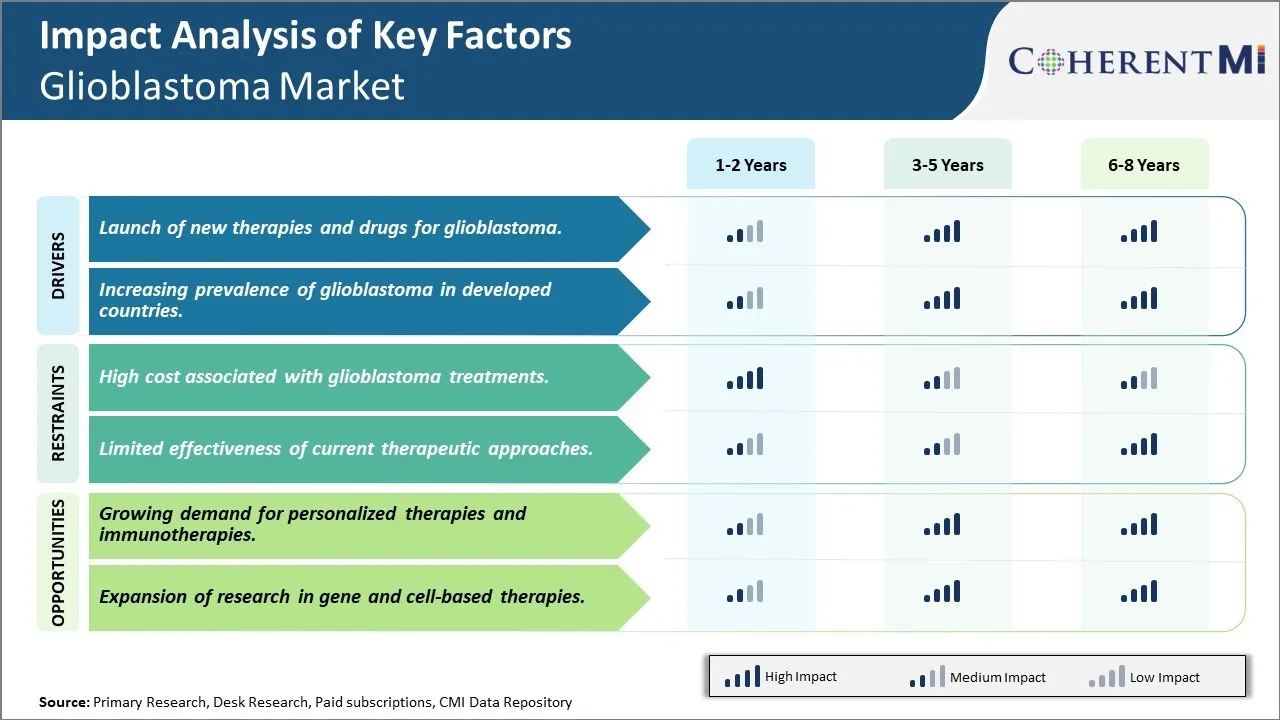Glioblastoma Market Trends
Market Driver - Launch of new therapies and drugs for glioblastoma
The glioblastoma market has been witnessing significant developments over the past few years due to rising focus on development of novel and innovative treatment options. Pharmaceutical companies and biotech firms have ramped up efforts to identify new drug candidates and therapy procedures that can help improve patient outcomes. A key focus has been on developing targeted therapies against specific molecular alterations associated with glioblastoma tumors. This is a critical area of research as it holds potential to offer more personalized and effective treatment strategies.
Several biotech have shown promising results from early clinical trials of targeted drugs against genetic mutations seen in a subset of glioblastoma patients. A few recent examples include a phase II trial of a BRAF inhibitor that demonstrated encouraging response rates in patients with BRAF V600E mutated glioblastoma. Another ongoing phase I/II study is evaluating a MEK inhibitor in combination with standard chemotherapy for MEK mutated glioblastomas. Results so far have been quite positive in slowing tumor growth. Large pharmaceutical companies are also exploring uses of existing oncology drugs for glioblastoma indications through biomarker-guided clinical trials.
Immunotherapy is another therapy category attracting heavy investments as a treatment approach for glioblastoma. Multiple cell therapy developers are conducting trials of engineered T-cell therapies and immune checkpoint inhibitors either as monotherapies or in combination with other treatments. Experts remain cautiously optimistic about the potential of immunotherapies to provide durable responses for at least a subset of glioblastoma patients, based on early data. The launch of newer immunotherapies targeting glioblastoma-specific tumor antigens could expand the market opportunities significantly in the coming years.
Advancements are also being made in gene therapy with several clinical studies ongoing to evaluate the safety and efficacy of various viral vector-mediated approaches. These include attempts to deliver tumor suppressor genes like p53 or suicide genes selectively to glioblastoma cells. The gene therapy research pipeline remains active with more candidates expected to enter human testing in the near future.
Market Driver - Increasing prevalence of glioblastoma in developed countries
Another important factor influencing the glioblastoma market landscape is the rising prevalence rates seen in developed countries primarily attributed to aging populations. Glioblastoma incidence is known to increase with age, with the average age of diagnosis being around 64 years. With significant improvements in life expectancy and medical advancements extending the human life span, the number of elderly individuals has swelled rapidly in North America and Western Europe in particular over the past few decades.
Research studies have established that the risk of glioblastoma almost doubles for every 10-year increase beyond the age of 50 years. Therefore, with larger proportions of the population classifying as geriatric, this age group is expected to fuel greater demand for glioblastoma therapeutics. Additionally, greater access to advanced diagnostics like MRI scans has led to more glioblastoma cases being accurately identified and reported now compared to the past. All these elements have contributed to the growing prevalence numbers seen widely across developed markets.
According to some estimates, over the next 20 years, the geriatric demographic constituting individuals aged 65 years and above will grow by over 50% in the United States alone. This impending surge in the aging population base of major pharmaceutical markets is poised to significantly impact brain tumor incidence rates in the long run. With glioblastoma exhibiting a strong predilection towards affecting the older population, its prevalence is expected to rise in parallel, heightening the need for improved screening and treatment protocols. The mounting disease burden resulting from shifting demographics certainly promotes prospects within the glioblastoma therapeutics area.

Market Challenge - High cost associated with glioblastoma treatments
One of the major challenges being faced in the glioblastoma market is the high cost associated with glioblastoma treatments. Glioblastoma is one of the most aggressive forms of brain cancer and the available treatment options such as chemotherapy, radiation therapy and targeted therapy are often very costly. The prices of drugs used in chemotherapy can range from tens of thousands to hundred thousands of dollars for a course of treatment. Additionally, glioblastoma treatment often requires longer hospital stays, repeated imaging and surgical procedures which collectively contribute to heightened medical costs. This financial burden is difficult to bear for many patients and their families. The exorbitant cost of treatment is also challenging for public and private health insurers to cover. As a result, only a limited number of high-income patients are able to afford the high-end treatment options. This inevitably poses barriers to access and puts several low-income patients at high risk of non-adherence to therapy due to cost factors. Pharmaceutical manufacturers need to focus on reducing drug prices to enhance affordability without compromising treatment efficacy. Insurers and governments also need to explore mechanisms to subsidize costs for needy patients. If the financial barriers to treatment are not addressed proactively, it may negatively impact the overall market potential for glioblastoma drugs and diagnostics.
Market Opportunity - Growing demand for personalized therapies and immunotherapies
One key opportunity being witnessed in the glioblastoma market is the growing demand for personalized therapies and immunotherapies. Research efforts in the domain of precision medicine and immunotherapy are unlocking new scientific avenues for more effective glioblastoma treatment. The adoption of genomic profiling and biomarker screening enables tailored therapeutic strategies customized to an individual patient's molecular profile and disease characteristics. This personalized approach holds promise to maximize treatment response while limiting toxicities. Similarly, immunotherapy is emerging as a game-changing approach that leverages the body's immune system to fight cancer. Drugs targeting immune checkpoints like CTLA-4 and PD-1 pathways have demonstrated survival benefits in clinical trials for glioblastoma patients. The success of novel therapies like CAR T-cell therapy has also stimulated interest. As healthcare enters an era of individualized care, products enabling personalized precision therapies and immunotherapies are likely witness increased demand. This presents lucrative opportunities for innovative drug makers to gain market share through cutting-edge treatments tailored for glioblastoma patients.